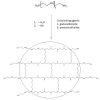Nanoparticles of Quaternary Ammonium Polyethylenimine Derivatives for Application in Dental Materials
- PMID: 33143324
- PMCID: PMC7693368
- DOI: 10.3390/polym12112551
Nanoparticles of Quaternary Ammonium Polyethylenimine Derivatives for Application in Dental Materials
Abstract
Various quaternary ammonium polyethylenimine (QA-PEI) derivatives have been synthesized in order to obtain nanoparticles. Due to their antibacterial activity and non-toxicity towards mammalian cells, the QA-PEI nanoparticles have been tested extensively regarding potential applications as biocidal additives in various dental composite materials. Their impact has been examined mostly for dimethacrylate-based restorative materials; however, dental cements, root canal pastes, and orthodontic adhesives have also been tested. Results of those studies showed that the addition of small quantities of QA-PEI nanoparticles, from 0.5 to 2 wt.%, led to efficient and long-lasting antibacterial effects. However, it was also discovered that the intensity of the biocidal activity strongly depended on several chemical factors, including the degree of crosslinking, length of alkyl telomeric chains, degree of N-alkylation, degree of N-methylation, counterion type, and pH. Importantly, the presence of QA-PEI nanoparticles in the studied dental composites did not negatively impact the degree of conversion in the composite matrix, nor its mechanical properties. In this review, we summarized these features and functions in order to present QA-PEI nanoparticles as modern and promising additives for dental materials that can impart unique antibacterial characteristics without deteriorating the products' structures or mechanical properties.
Keywords: antibacterial agents; dental composite restorative materials; nanoparticles; quaternary ammonium polyethylenimine.
Conflict of interest statement
The authors declare no conflict of interest. The funders had no role in the design of the study, the collection, analysis, or interpretation of data, the writing of the manuscript, or the decision to publish the results.
Figures












References
-
- Watts D.C. Dental Restorative Materials. In: Cahn R.W., Haasen P., Kramer E.J., editors. Materials Science and Technology: A Comprehensive Treatment. Vol. 14. VCH; New York, NY, USA: 1992. pp. 209–258.
-
- Padovani G.C., Fùcio S.B.P., Ambrosano G.M.B., Correr-Sobrinho L., Puppin-Rontani R.M. In Situ Bacterial Accumulation on Dental Restorative Materials. CLSM/COMSTAT Analysis. Am. J. Dent. 2015;28:3–8. - PubMed
Publication types
Grants and funding
LinkOut - more resources
Full Text Sources

